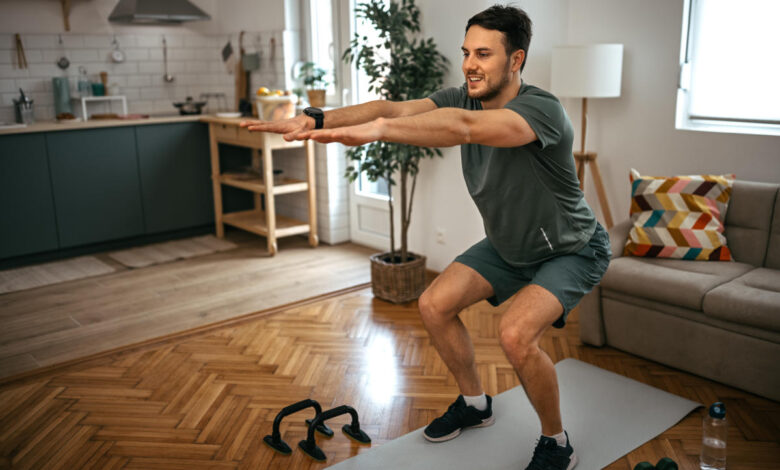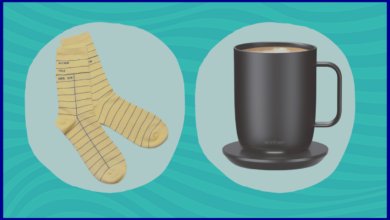5 easy exercises to prevent knee pain from a personal trainer

About 25% of adults have knee pain — a number that’s gone up by nearly 65% over the past two decades — and if you’re one of them, you know how much it can interfere with daily life. Walking upstairs, standing up from sitting and even taking an evening stroll with your pup can feel like painful chores when your knees start acting up. Although knee pain can come with age, knee injuries can happen to people of all ages. As a personal trainer and strength and conditioning specialist, I see plenty of knee pain issues, even in high school athletes.
Throughout the day, knees support your body weight and deal with different types of pressure, tension and stress. Doing the same daily movements can cause wear and tear on the joint and its supporting structures, Mark Gugliotti, associate professor of physical therapy at the New York Institute of Technology, tells Yahoo Life.
Because the knee is sandwiched between the hip and ankle joints, which both have more mobility than the knee, if either joint is unstable or not quite mobile enough, the knee can take the majority of the damage due to its stable design, according to Jake Schaake, chiropractor and CrossFit coach with PALM Health in St. Louis, tells Yahoo Life. “Imbalances in the quadriceps and hamstrings can also lead to ‘pulling’ on certain parts of the knee,” he adds.
Injuries, arthritis, weak hip muscles and limited ankle mobility can all contribute to knee pain. Identifying the cause of your knee pain can help prevent it, but that’s sometimes easier said than done. The good news is that there are effective exercises to help prevent knee pain that work for most people.
5 exercises to prevent knee pain
Strengthening exercises can help manage pain for people with knee osteoarthritis and can prevent pain from happening in the first place. These exercises make the muscles around the knee stronger and better at handling endurance. As a result, this boosts joint stability and will give you more confidence in your movement.
It’s important to use proper form to avoid getting hurt. If you’re new to these exercises, it may help to work with a trainer or coach to make sure you’re doing them right. If any new movement causes you discomfort, stop doing it or try going at a slower pace.
Wall slides
Wall slides are a quick and accessible exercise you can do anywhere that packs a lot of punch. They strengthen key muscles supporting the knee joint, improve balance and posture, and increase knee range of motion without putting a lot of pressure on your joints.
They will also help with knee pain, injury recovery and everyday knee functioning. What does this mean? Walking, getting up from your chair and climbing stairs will all become easier and less painful.
Here’s how to do a basic wall slide:
-
Stand up straight with your back against a wall and your feet hip-width apart.
-
Raise your arms, pressing your shoulder blades into the wall. The backs of your hands should touch the wall, and your thumbs should be at head height. Your upper arms, from your shoulders to your elbows, should be perpendicular to the floor.
-
Breathe in. Slowly bend your knees and slide your back down the wall until your knees are bent at a 45-degree angle. Bending further can strain your knees.
-
As you bend your knees, straighten your elbows until your arms are extended straight up over your head, still against the wall.
-
Hold this position for five seconds.
-
Breathe out as you straighten your knees to slide back up the wall until you are fully upright with knees straight and elbows bent back to their starting position.
-
Repeat this five times, and gradually increase to 10 or 15 reps as your quad strength improves.
Glute bridges
If you want a simple, single exercise that can strengthen your glutes, knees and core muscles while relieving knee pain and improving balance, try glute bridges. By strengthening your glutes and lumbopelvic region (which includes the spine and pelvis), glute bridges help stabilize the lower back and improve knee stability. They are a relatively straightforward exercise that almost anyone can do, regardless of your fitness level.
Here’s how to do them:
-
Lie on your back with your knees bent and your feet flat on an exercise mat or the floor. Your feet should be close enough to touch with your fingertips.
-
Press your lower back into the mat and tighten your stomach muscles.
-
Place your hands on the mat, palms up or down. Lift your hips, squeezing your buttocks and keeping your chest open.
-
Do not overarch your back or tuck your chin. Lower your hips back down until your lower back touches the mat.
-
Repeat the movement, exhaling as you lift your hips and inhaling as you lower them.
-
For a more challenging version, raise one leg straight up, keeping your knee in line with your hip while maintaining good form and alignment.
Monster walks
Monster walks not only sound fun, but they’re also a neat way to increase strength in the muscles that help stabilize your hips and pelvis — the very joints that, if unstable, will lead to knees joining the pain party. This banded stepping exercise can alleviate knee pain because it strengthens the muscles around your knee joint as well.
Monster walks also work the muscles in your thighs and core, which are also crucial for healthy knees. These funky banded steps also increase your hip mobility and build stability and balance to prevent falls.
Here’s how to do monster walks:
-
Wrap a resistance band around your thighs, ankles or both.
-
Bend your knees into a quarter squat position.
-
Step forward with one foot, then the other, while maintaining tension on the band.
-
Continue this walking motion for 10 to 15 steps.
-
You can also walk backward in the same way.
Jumping
High-impact exercises like hopping and jumping might seem like the last thing you’d want to do to prevent knee pain, but it’s quite the opposite. Impact exercise helps build and preserve your muscle and bone tissue for healthy joints.
Findings published in the Journal of Bone and Mineral Research show that impact exercises, especially jumping from side to side, can improve thigh bone strength, the amount of minerals in the bone and even its shape in women who have gone through menopause — all without causing damage to the cartilage in the knee. Keep in mind that these exercises may not be appropriate for people who have osteoarthritis or current knee pain.
Hopping and jumping are part of quite a few types of sports and exercises, but there’s an easy way to incorporate jumping into your exercise routine.
Here’s how:
-
Do 30 double-leg hops
-
Do 15 reps of alternating single-leg hops for each foot
-
Do 10 reps each of double leg forward, side and back hops. The distance should be six to 12 inches.
-
Do 10 reps of single-leg hops
-
Do five reps of double-leg rotational hops (i.e., spin) with a 90-degree turn midair
-
Do five reps of double leg rotational hops with a 180-degree turn midair
Split squats
Split squats — and really all types of squats — are excellent for strengthening the muscles around your knees. Stronger muscles help absorb shock and reduce the stress on your knee joints. Split squats in particular improve balance, stability and mobility of your knee joint, and the single-sided nature of the exercise works to correct any muscle imbalances between your legs.
One warning: “If your knee pain stems from patellofemoral syndrome,” which is a condition characterized by pain around the kneecap, “you may want to avoid squatting and lunging activities until you’re able to strengthen the other muscles around the knee joint that help keep your kneecap in proper alignment,” Dr. Christynne Helfrich, physical therapist and orthopedic certified specialist at Hinge Health, tells Yahoo Life.
Here’s how to do them:
-
Stand up straight with your feet hip-width apart. Step forward with one leg, creating a split stance. Keep your back heel off the ground, chest up, shoulders back.
-
Bend both knees to lower your body until your back knee is close to touching the floor. Keep your upper body upright and your front knee aligned over your ankle. Avoid letting your knee cave inward.
-
Push through your front heel to return to the starting position. Keep your core tight and maintain your balance throughout the movement.
-
Complete the desired repetitions on one leg before switching to the other.
Rachel MacPherson is a personal trainer, certified strength and conditioning specialist and exercise nutritionist.




